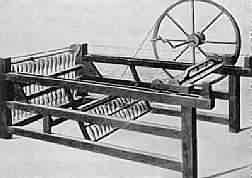
With such discoveries it was beginning to appear that Christianity's view of nature and the world could not stand up to the tests of experimental reason. When the Diests maintained the architect of Nature could have only the qualities manifest in his handiwork, many Christians took the view that their religion did not need to submit to the debasing tests of rationality.
Again, when the Diests, and later the Skeptics and Atheists dismissed biblical prophecy and revelation as offensive to the rational mind, the church fought back with John Wesley's assertion that reason could not produce the love of God.
The Enlightenment was a flow of ideas which formed and shifted under the impact of new evidences, insights and philosophies. Nature, which had once been considered visible proof of the existence of God and His benevolence, now became an object of scientific curiosity, and a theatre in which to practise rational thinking.
I
n
d
u
s
t
r
y
When the Industrial Revolution began in the mid 18th century it marked the passage of an agrarian, handicraft based economy, to an economy based on machines and commerce. At the heart of the Industrial Revolution was the application of knowledge to the devising of methods of efficient production. With the expansion of scientific knowledge inventors began to apply practical innovations to the making of goods and the division of labour.
Steam was the new source of power. Innovations in iron and steelworking ended the artisan workshops of towns and villages. In the field of textiles, machines such as the spinning jenny of James Hargraeves in 1765, were built so large they had to be driven by inanimate power. The old technology on the medieval model of workshops relying on human power in rural cottages could not compete with work that was efficient, centralized, organised and distributed in factories and mills.
 When the machine loom displaced the hand loom weaver, records of the time showed productivity increases of the order of 10:1. Cotton fibres lend themselves well to mechanical handling, as compared with wool and the value of exports of these textiles was correspondingly higher. Between 1769 and 1829 wool exports from Britain doubled while that of cotton grew eighteen fold. Between 1801 and 1851 economic output in Britain tripled.
When the machine loom displaced the hand loom weaver, records of the time showed productivity increases of the order of 10:1. Cotton fibres lend themselves well to mechanical handling, as compared with wool and the value of exports of these textiles was correspondingly higher. Between 1769 and 1829 wool exports from Britain doubled while that of cotton grew eighteen fold. Between 1801 and 1851 economic output in Britain tripled.
By the middle of the 18th century the governments of Europe were actively seeking to promote Industrial Development by providing subsidies in the form of low cost loans, exemptions from taxes, technical assistance, and monopoly privileges to innovators of new products or processes.
An assured supply of labour was granted from prisoners, vagabonds, serfs and orphans especially in Western and Central Europe. In some cases, particularly in the manufacture of armaments, the government itself went guarantor, at once securing employment and income. State sponsorship of industry proved to be a political masterstroke and in the British Empire and New World, opportunities for advancement and wealth opened up.
The late 19th century saw stunning growth in transport technology, particularly in the building of railways and steamships, where there was a need for steel in far greater quantities than ever before.
The social consequences of the Industrial Revolution were a deterioration in housing brought about by thousands of migrants pouring into urban centres along with the extensive reliance on women and children for cheap labour in factories. In Britain the factory act of 1833 set a minimum age of nine years and limited the hours of children to eight per day.
In 1859 Charles Darwin presented the principal of evolution, in which it is theorised that lasting and beneficial change comes about by slow and small degrees. Examples of evolutionary change were to be found in plant cultivation, animal domestication, selective breeding and the mutations of bacteria and viruses.
That species might change into other species was the underlying concept of evolution and the starting point for the science of anthropology and the search for the origin of mankind.
 In 1808 Dalton's study of the atom provided the basis for organic chemistry which was to lead, in the century to follow, to Watson and Crick's discovery of DNA or the buildings block of life.
In 1808 Dalton's study of the atom provided the basis for organic chemistry which was to lead, in the century to follow, to Watson and Crick's discovery of DNA or the buildings block of life.
In the 19th century most people in the Western World held to an underlying faith in the reality of all the things materialistic science denied. Religious belief, moral responsibility, and mankind's status in the universe, was that of a being created in the image of God.
The 20th century reversed this kind of thinking. Science showed the world was made out of atoms which obeyed natural laws. Discoveries in physics and chemistry began technological advances in the 20th century the like of which the world has never seen.
When books were first printed in the 16th century, new knowledge suddenly entered the public consciousness, bringing about a spurt of growth, and a significant increase in the knowledge base, education and literacy of the masses.
 | Click for more |
